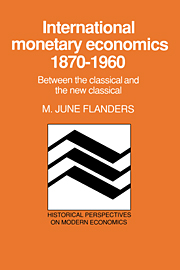Book contents
- Frontmatter
- Contents
- Preface
- 1 Preliminaries
- 2 Stream P
- 3 The beginnings of the neoclassical tradition
- 4 The locus classicus of the neoclassical position
- 5 The Macmillan Committee
- 6 A second diversion: Keynes and the Macmillan Committee
- 7 The anti-neoclassicals
- 8 Indian currency and finance: a tract on monetary reform
- 9 A treatise on money
- 10 Late Keynes: towards Bretton Woods
- 11 The crisis writers
- 3 Stream F
- 4 The confluence
- Ex post
- Bibliography
- Index
4 - The locus classicus of the neoclassical position
Published online by Cambridge University Press: 12 October 2009
- Frontmatter
- Contents
- Preface
- 1 Preliminaries
- 2 Stream P
- 3 The beginnings of the neoclassical tradition
- 4 The locus classicus of the neoclassical position
- 5 The Macmillan Committee
- 6 A second diversion: Keynes and the Macmillan Committee
- 7 The anti-neoclassicals
- 8 Indian currency and finance: a tract on monetary reform
- 9 A treatise on money
- 10 Late Keynes: towards Bretton Woods
- 11 The crisis writers
- 3 Stream F
- 4 The confluence
- Ex post
- Bibliography
- Index
Summary
The neoclassical view is that which is typically regarded as the statement of the “rules of the game” of the gold standard. A widely cited source of this view is the Cunliffe Committee Report, written in 1918, describing the workings of the prewar system. Thirteen years later, the Macmillan Committee gave a drastically different view of how the prewar system had in fact worked. Furthermore (and more interesting), it appears that the Cunliffe Committee described a system that never had existed: the difference between their description of the system and a more detailed analysis of the operations of the Bank of England, Sayers (1936), is striking.
Emphasizing the Bank of England's activities here is, I think, perfectly justified. The revisionists argue that the prewar gold standard was really a sterling standard (see Chapter 7). But even hard line gold standardists would agree that Great Britain was very much at the center of the system and that the Bank of England played a crucial and leading role in its working.
The Cunliffe Committee and its report
The Cunliffe Committee, the “Committee on Currency and Foreign Exchanges after the War,” was appointed by the Treasury, in January 1918 “to consider the various problems which will arise in connection with currency and the foreign exchanges during the period of reconstruction and report upon the steps required to bring about the restoration of normal conditions in due course.”
- Type
- Chapter
- Information
- International Monetary Economics, 1870–1960Between the Classical and the New Classical, pp. 67 - 86Publisher: Cambridge University PressPrint publication year: 1990



